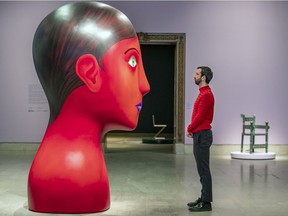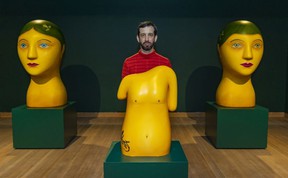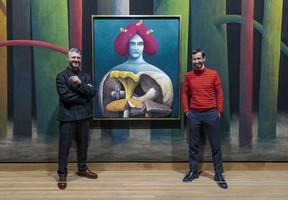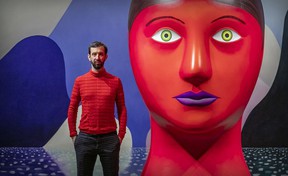“I’m not part of the school of art that says things should be hard,” says the Swiss-born artist, whose Montreal Museum of Fine Arts show opens Feb. 12. “If you’re visually amused, that’s fine with me .”

Postmedia may earn an affiliate commission from purchases made through our links on this page.
Article content
Talking to Nicolas Party, the word “play” and variants thereof come up a lot.
advertisement
This advertisement has not loaded yet, but your article continues below.
Article content
The Swiss-born painter and sculptor, now based in New York, first came to painting as a teenage graffiti practitioner — “trying to stay one step ahead of the cops” was integral to the experience, he recalled. Party has carried some of that anarchic spirit through to his present practice, consisting largely of colour-saturated landscapes, portraits, still lifes and large-scale sculptures that have made him one of the most in-demand artists on the contemporary world scene.
Asked what he would like visitors to take away from L’heure mauve, his major new show at the Montreal Museum of Fine Arts, he responded with something of a mission statement.
“I want the experience to be easy,” said the cool 41-year-old. “I’m not part of the school of art that says things should be hard — that in order to appreciate it you have to read a lot about it and study it. If you’re visually amused, that’s fine with me.”
advertisement
This advertisement has not loaded yet, but your article continues below.
Article content
Amusement, while all but guaranteed, is far from the only emotion visitors are likely to feel. Childlike yet layered with references to art history, Party’s work is rigorous but — yes — playful.

Arranged on the theme of humankind’s relationship to nature, with all the good and bad thus implied, the show places Party’s pieces alongside works he has chosen from the MMFA’s collection, many of them Canadian landscapes. The artist has also been given carte blanche to effectively customize the space in which the art is shown; the result is a sumptuous, immersive experience enhanced by the musical accompaniment of Pierre Lapointe’s thematically linked songs.
For Party, an early spark for the show came on a visit to Montreal 10 years ago. It was then that he first encountered the work of Lawren Harris and the Group of Seven, which, he noted, “is hardly known in Europe. It was wonderful for me to discover this fantastic history of landscape painting. It’s very different from European art. You see Lawren Harris and you know it’s not from France.”
advertisement
This advertisement has not loaded yet, but your article continues below.
Article content
Immediately noticeable on viewing Party’s paintings is the prevalence of pastels, a medium that places him in kinship with an 18th-century Venetian tradition in which women artists came to the fore.
“I didn’t know that when I started using pastels,” he said. “It was intuitive. I fell in love with the medium. You’re working with your hands. It’s very sensual and very fragile. The colors are bright. And it’s fast. Unlike oils, there’s no drying process.”

Among the many striking things about Party’s customizing of the show’s space is the realization that going into a room with an arched entryway feels different.
“In an old-style stone arch, everything from both sides is drawn to the middle,” he said. “The weight and energy of the whole structure is right above your head. The idea, back then, was that you’d be humbled by the strength of God. I kind of like playing with that symbolism, of echoing some of those aspects.”
advertisement
This advertisement has not loaded yet, but your article continues below.
Article content
As for the thinking behind the rich, varied hues on the walls of each room, Party said: “When you look at a painting hung against a white backdrop, most of the light that’s in the room is coming back at you. You’ve got too much light around the painting. It physically eats up the painting from the outside.”
Engaging with works by artists of earlier epochs, does Party feel like he’s conversing with them across history?
“I’d say it’s a dialogue with the objects, not the artists themselves,” he said. “I make a distinction between the artist and the work.”

Is there a risk that comes with recontextualizing historical works?
“Putting, say, an Otto Dix painting in a different setting, even in a cave, won’t make it any less great a painting,” Party said. “The work is stronger than anything else. Putting it in a different context for a few months is not going to hurt it. The history that the work has been through will not disappear.
advertisement
This advertisement has not loaded yet, but your article continues below.
Article content
“And you know, as an artist you have to be confident that you’re allowed to do these things. If you’re not, you’ll never do anything.”
Is part of Party’s free-ranging relationship with art history a desire to be included in that history’s grand sweep?
“Sure, but it’s not a big ambitious thing,” he said. “It’s more like these (works) are the people I want to be in the same room with. It’s like wanting to be with someone you love. I’m not scared of these artworks. I want to hug them, to embrace them.”
Given that there are huge murals in this show that will be destroyed after the exhibition closes, works lovingly created in situ over the last two months, does Party feel a kind of separation anxiety?
“Not really, no. The important moment is when you do it. It’s the making of it, and the urgency of that, that really matters. And anyway, at the end of the day, every artwork made by humans will eventually disappear.”
AT A GLANCE
Nicolas Party: L’heure mauve opens Saturday, Feb. 12 and runs through Oct. 16 at the Montreal Museum of Fine Arts, Michal and Renata Hornstein Pavilion, 1380 Sherbrooke St. W. For information on tickets and hours, visit mbam.qc.ca.
-
‘We are their voices’: New Holocaust museum to open on Main
-
New book shines a light on important figure in Canadian art history
-
Heather O’Neill conjures a parallel-world Montreal in When We Lost Our Heads


